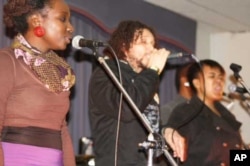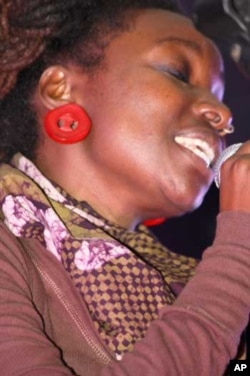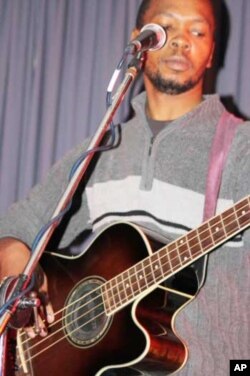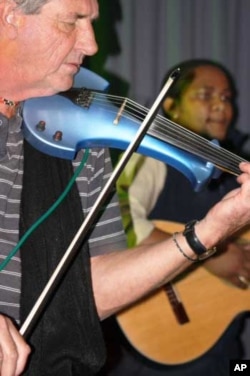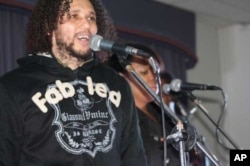This is Part 5 of a 5-part series: New Sounds of Africa
Continue to Parts: 1 / 2 / 3 / 4 / 5
“I can’t remember when music wasn’t a part of my life,” said South African singer and songwriter, Sebastian Jamieson. He laughed, “I think the first time I did a live performance was at my pre-primary graduation (at five years of age). I sang ‘Ebony and Ivory’ by Paul McCartney and Stevie Wonder.”
Jamieson is a major part of a remarkable project that has blended music from South Africa, Lesotho, Kenya, and even elements of European folk, to form a rich, soulful amalgam of sound.
“We call ourselves The NIA Collective. ‘Nia’ is Swahili for ‘purpose.’ We got attracted to that word because our music has purpose. It’s fun, but it’s not just music to dance to or to listen to; our songs generally have strong themes that make people think,” vocalist Injairu Kulundu told VOA.
It’s Kulundu who gives the band strong Kenyan and Sotho influences. She explained, “I’m kind of a hybrid – I grew up in western Kenya; my roots are in the Luhya culture. Then, when I was eight, our family moved to Lesotho…so I’m also steeped in Sotho culture. Now, I live and work in South Africa.”
‘Swinging vibe’
Kulundu said African lingala music plays a “huge” role in the NIA Collective’s sound. This is guitar-driven dance music layered with harmonized vocals that originated in central Africa. It spread to Kenya in the 1970s with the likes of the Super Mazembe band.
“You’d call it a kind of salsa; the swinging vibe of the music. Those harmonies and those rhythms get in (to our music),” said Kulundu. “Also, another fundamental part of our sound is traditional African call and response music. The very nature of this, the way it’s structured, means it can’t be sung by just one person. So our music is written for a few voices, not just one voice.”
But the Collective doesn’t embrace only lingala; its music is a mix of genres. “People always ask us what our music is; how we would categorize it. (It’s) afro-soul, funk, fusion, afro-pop, jazz, afro-indigenous,” Kulundu said.
What she most enjoys about her group’s sound is its “rhythmic basis. We love experimenting with different rhythms. Then there’s also this sweetness…and this melody that is soul, really….”
Classical Hungarian sounds
The Collective uses instruments associated with modern pop music, such as a bass guitar, drums and acoustic as well as electric guitars. But one of its members has brought elements to its sound that are “about as far away from traditional African-made music as one can get,” said Jamieson.
Lawrence Sisitka is a master of the violin, fiddle and mandolin. “Those instruments are European and American folk music instruments, really,” Jamieson pointed out. Kulundu added, “Lawrence was born in Hungary, and is actually trained in classical music. What he plays on the violin and on the mandolin, it brings some of that with it and blends it with all these other (African) rhythms and harmonies and the sweetness; it’s really an eclectic mix.”
The singer described Sisitka’s inclusion in The NIA Collective as “totally uncontrived. It’s not like we sat down and said, ‘Let’s create something completely off the wall and use fiddle and mandolin in our music.’ It was more like we wanted to involve a brilliant musician in our band, and fiddle and mandolin happened to be his instruments of choice. So we were forced to incorporate them, in a way.”
Jamieson said it is elements like Sisitka’s and Kulundu’s influences that make it “hard to classify” the bands’ music “because each person from their background brings in a different element – like the languages, like the different styles of playing, like the different instruments.”
‘I Cry Sometimes’
The NIA Collective prides itself on being socially conscious. “We make music from the heart,” Jamieson insisted. “We don’t really focus on making music trying to impress (fellow) musicians…. We’re all about relating a message, sharing something of ourselves – with a social justice element to it.”
Perhaps this is why, said Jamieson, his band’s sets are generally “very intimate. It’s not the kind of stadium vibe; it’s more purposeful.”
Group members are all involved with social issues, advocating, for example, for women’s and children’s rights…but also for the rights of men to free themselves from societal norms.
In this respect, Jamieson referred to his song, ‘I Cry Sometimes.’ He explained, “The song’s about society having this picture of what a man is supposed to be, that whole ‘cowboys don’t cry’ attitude where the man is just the protector and the provider but no emotional side to being a man is tolerated; that side of being a man is always suppressed. As soon as a man shows emotion, he’s still seen by society as weak.”
Jamieson disclosed that it was something that Kulundu had said, reflecting her Sotho background, that inspired him to write ‘I Cry Sometimes.’
“There’s a Sotho proverb that says…’Even when a sheep gets slaughtered, it still doesn’t cry.’ That’s kind of like how men are seen in society – even though we are slaughtered we still don’t cry; we don’t show it (emotion).”
Through his song, Jamieson said he’s “trying to get beyond that stereotype and just showing that a man can still be the provider, he can still be the protector – but he’s also allowed to feel, because only then can he truly be himself and truly be one hundred percent human.”
Songs about triumph, not defeat
But, despite the serious current running through The NIA Collective’s work, the group’s gigs are far from depressing affairs. The lyrics of some of the band’s songs do indeed leave room for introspection, but the melodies and soaring harmonizing are infectious and uplifting.
“If you listen to our songs, no one is ever defeated in them. They are about people triumphing in difficult circumstances, not about people being defeated by hardships and wallowing in self pity,” said Kulundu.
Jamieson commented that the Collective’s “warmth” comes from the group’s personalities. “We all have a very positive outlook on life, and that weaves into the music. It’s not that we try to artificially make that vibe happen. It’s just something natural and we’re really blessed in that way as the Collective.”
The band hopes to release its debut album by the end of the year. “We really want to try and put together the stuff, just as a testament to what we’ve been up to. It’s not necessarily that we want to go big or anything; it’s just to have the music (in the form of an album),” said Kulundu.
But, added the vocalist, if this doesn’t happen, “It won’t destroy the Collective. We’re too strong for that. As long as the music is coming out of us, we’ll always be keen to make it.”




